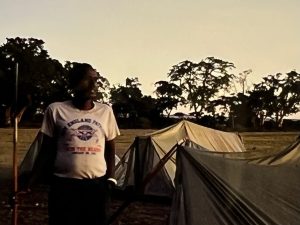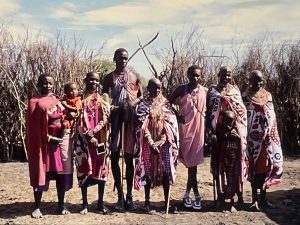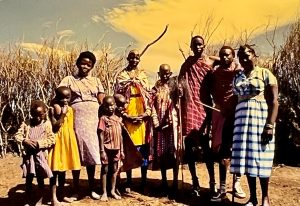
Age thirteen, in the photo booth
Photo booths might be thought of as a sort precursor to digital instant selfie pictures. Go in, pull the curtain, put in the money, pose in the mirror, and minutes later get pictures of yourself spit out of the machine. For extra fun, bring in a friend and ham it up.
We could hear dull, throaty roars in the distance. We were more than happy, thank you very much Mr. Guard, to be accompanied across the field. Would they be willing to have us take their picture the next day, once there was light, if we gave them a copy? Indeed, they would.
This was novel at a time when pictures were analog, requiring developer and darkness to process. The usual drill, if you didn’t have your own darkroom, was to carefully load in the cartridge (taking pains to avoid direct light that might leak in), wind the film up, take pictures with manual adjustments, and carefully unload the cartridge once you reached the end of the film. Then take it to a commercial developer and wait at least a week before seeing the results. Unless you had someone to take a picture of you, or were adept with time-delay shots, pictures captured your view from behind the lens.
As cameras transitioned to digital, it could be hard to display the photos unless you transferred them to a computer or disc, and it required a large band width to send them to others. This of course changed completely with the now-ubiquitous smart phone camera that air drops to friends and posts to social media. But technology ever continues to evolve, and old pictures can become inaccessible, so there is still an argument to be made for a hard copy of an image. In fact, I have lots of color slides that I haven’t yet managed to transfer into digital or hard copies, despite a purchasing a black box that promised to help, and who has a slide projector?
Taking travel pictures was particularly challenging in the pre-digital era. When we took a long trip to Africa in 1989, we carried multiple rolls of slide film (to maximize color vibrancy) packed into a dark foil bag to protect them from luggage Xray machines, along with a single lens reflex camera and zoom lens. We had to carry the exposed film until we found a place that could develop it, then carry the packages of slides until we got home. We couldn’t wait to see the pictures, so acquired a simple slide viewer to give a decent preview, which we also had to carry.
It’s worth noting that this trip was also before luggage had wheels, and we had soft-sided bags that could be turned into backpacks instead. I can’t imagine how we carried everything for months on end, but then again, we were more than thirty years younger.
As if that weren’t enough to lug around, at the last minute we invested in a new toy, a Polaroid Instamatic. It was a bit clunky, but it could both take and develop a picture with its special film, one at a time. The camera ejected a partially completed photo that had to sit for a bit before a layer was peeled off to reveal the wondrously near-instant picture. Our idea was that we could use it if we wanted to take pictures of people, so we could share them. It could be, if you will, a sort of ersatz photo booth.
We finally had a chance to try it out while on our budget safari in Kenya. Our little tents were camped in a field at the edge of the Masai Mara game reserve, about thirty yards from the site’s latrine. A couple of tall Masai dressed in the traditional red blankets and armed with long spears gathered next to a small campfire: they were our guards, to protect us from lions. If we needed to use the latrine at night, one of them would accompany us to the spot, then back to our tent. This seemed a little silly—the latrine wasn’t that far away, and was that really necessary? However, when night fell there were no lights except the campfire, everything was unnervingly dark, and the latrine barely visible. We could hear dull, throaty roars in the distance. We were more than happy, thank you very much Mr. Guard, to be accompanied across that field. Would they be willing to have us take their picture the next day, once there was light, if we gave them a copy? Indeed, they would.
They did appear then next morning for their picture as promised, proudly changed into their best tee shirts and pants. That was a bit disappointing, but of course they wanted to change out of their everyday clothes and get dressed up for a picture—wouldn’t you? We were just happy they were willing to oblige. We used the Instamatic and gave them their portraits, which brought big smiles when it did its magic, and they allowed us to use the SLR camera with its slide film for our own copy.
We stayed at the camp that day, visiting the nearby village and going for game drives. Then we were approached with a special request. The following day, a local couple was getting married, and they heard we had a special camera–could we take some pictures for them before we headed onward? Yes, yes, yes! And so we became photographers for the wedding party—bride, groom, friends and relatives. The ones from the big city were in their western clothes, while the others wore more traditional outfits, some enhanced by fancy sneakers. One of us operated the Polaroid and the other the SLR, and there were many more big smiles once they had their instant pictures in hand.
Sometimes taking pictures creates an uncomfortable distance between subject and photographer. In this case, our photo booth on safari gave us an opportunity to connect and share joy, for which I am still grateful.






Fantastic description of what it took to get a picture back in the day, Khati. And to take all that special equipment on safari, the Xray-proof bag, no wheels on the luggage, the new Polaroids; my goodness! I love that your Masai guards changed to their “day clothes” for the photo; not nearly as exciting for you, but thrilling for them. And then you became the wedding photographers on location.
My father and I never shot slides (my father-in-law did), so I have access to all the family photographs throughout the years. The old Polaroids (he too, became thrilled with the immediacy of the process) did not hold up well. The color didn’t hold, or they curled, or just disintegrated. He would put a backing on them to keep them from curling and that helped. He would even send them in to Polaroid for copies (I have some of those), which held up better. Of course, with the advent of digital, Polaroid has gone out of business, a timely innovation whose time has passed.
Yes, it is remarkable how the old photographs actually hold up as keepsakes, compared to the new inventions. It is an ongoing effort to transfer from one system to the other. I have a couple of pictures of family from the early twentieth century that remain dear—but how to store them?
Khati, I particularly love this story because I too went on a safari in Kenya and camped near the Masai Mara game reserve. All my photos are slides, and if I can even find the right boxes, I would love to have them made into prints or digitized.
I also love the age-13 photo booth photos that you use for your featured image. Taken in three different outfits, with two different hairstyles – any story attached to those, or just random photo booth photos you happened to have still?
It would be fun to compare pix someday! I’ll let you know if we find a decent way to revive the slides. I wish I had more of a story to go with the photo booth slides—all I can say is that they were taken during eighth grade, while I was in Switzerland—maybe on school trips. You can see I wasn’t sure how to look at the camera and I wasn’t trying to ham it up, and gee, I look young!
Oh, how I relate to this story, Khati…on so many levels! And it gives me an idea for another prompt…Polaroids! Can’t wait to suggest it at our next admin meeting. I feel sure we must all have some, although it might take some digging. I still have some film for my SX-70, long expired but who knows what cool effects might result. Now I’m itching to go play with it.
I, too, took a trip to Kenya…two cameras (both SLRs with multiple lenses), heavy protective bags of film…I shot 35 rolls!
Adorable pix of you at 13…especially love the one with the Peter Pan collar!
Expired film can indeed create some unusual effects—go for it! I don’t think I have any remnants from the Polaroid days, but that technology was revolutionary at the time. I’m glad you could relate to lugging around all the equipment—that plus maps and guide books took up a lot of space and weight. We still have a big carpet bag stuffed with ancient camera equipment and accoutrements that we don’t know what to do with anymore since the smartphone has sucked us into its spell.
What a great history/recollection of cameras and photographs, Khati. And particularly in the context of an African safari. Of course, as an anthropology major, I remember hearing all those tales — apocryphal or not — about Third World societies who feared that being photographed would “take away their souls.”
It sure has gotten easier, hasn’t it? I wonder if kids growing up now can even imagine not having an instantaneous image, let alone the whole, multi-step and time-consuming developing process — which I know only too well from my high school newspaper.
Yes, sometimes I feel like my memories come from the Stone Age. And yet we felt light years ahead of our parents, and maybe we were. I know that various peoples have viewed photographs as threatening, but in any case pointing cameras at people as if they were objects and without gaining consent is generally disrespectful at any time. And it feeds into racist tropes especially with Mizungus (Europeans) snapping away at Africans. It was nice to able to give a picture while taking one.
Khati, all your travel tales – as a child and as an adult – have been delightful to read, and have been eye-openers, this Kenyan one certainly no exception, I hope you’ll figure out how to post some pictures.
Years ago I traveled to South Africa, and am now thinking of the people, the landscape. the colonial city of Cape-town , the wonder of standing at the Cape of Good Hope, and the seeming vastness of the sky! Must go find the photos we took on that trip!
I’m glad you were inspired to think back on your travels too. South Africa is a beautiful country, and we were thrilled when they got rid of apartheid and we could travel to see it. Your old pictures must be somewhere…. Now I’m wondering where mine are (?more slides?). Sheesh.
If I figure out how to post my pictures, I’ll add them to the story.
I still haven’t gotten over having your own Masai warriors standing ready to escort you to the latrine, spears in hand, and keep the lions away! What a wonderful image. And I can empathize with your disappointment in having to photograph them in their “better” shirts and pants. Oh, Well, It was a well-told tale and a good creative direction for this prompt.
We were a bit unbelieving at the need for an escort to the latrine at first, but then we heard the roar—and now we’re believers….and with any luck, I’ll post the pictures.
What a fascinating history of this aspect of photography, Khati. Of course, I remember the magic of Polaroids and we took slides for many years, subjecting anyone who dared express interest in long slide shows of vacations and our first child’s early years. We did convert these slides to digital photos years ago at a photography store (do any exist anymore?). It was the best investment ever, as now they live on my computer and I can relive those memories and make photo books of them.
You were smart to have everything digitized when you did. I have been tempted to just turn over the slides to a pro, but there are too many, it quickly becomes super expensive, and I want to curate them better first, and you quickly get where this is going. Sigh. One day, when I am retired and can’t do much else due to, say, a pandemic it will be accomplished along with all the other things on my to-do list.
Extremely exotic, sleeping with the lions (awingawackawingaway). Were you comfortable that in the event of a surprise lion attack while you were latrining your personal Masai protector could defeat the lion? Did you have a Plan B in the event that the lion gained the upper hand, and part of a rib cage? Did they post a record of safari casualties in the advertisements? Do you have a preference as to which costume, traditional tribal or Western colonial, you prefer your guide to wear? Any update on the life of the married couple whom you captured in your magic photo box?
These days, with my chronicling every step and breath of my life with a selfie 🤳, the millions of years pre IPhones seem blown away with the cultures they usurped. For better or worse, although the evil in human nature, like waging war and killing, seems to continue to flourish.
Good questions. I’d have to say that I didn’t think too deeply about the risks involved–just as I learn to live with the risks of daily car commutes, plane rides, and random shootings (the stretch of highway on the way to work was an active sniper alley just before the Africa trip). My plan was to do what the locals recommended. The walking safari we did earlier in the trip was probably more dangerous, wading through water and climbing a tree to avoid some water buffalo. Although we did wonder about the Masai spear defense–and were assured that the Masai grew up as lion-fighters and were respected by the animals. All I can say is that they were much more of a deterrent that I would ever be. It is also odd how the animals don’t bother the tin cans (cars and vans) carting the tourists around, but step outside them and you are fair game, so to speak. The guides wore western clothes, but Masai still used the traditional garb, which was different and interesting, so maybe more photo-worthy–but being guarded by a spear was that by itself, and seeing the New England Patriots on the dress-up tee-shirt was interesting in its own right, as an expression of global interactions. No updates on the married couple alas.
Wonderful pics from many leagues along the time-space continuum. I know a few clubs I’ve played in that I wouldn’t have minded having someone to accompany me to the latrine. I take it the pic booth wasn’t in Kenya! I also loved the notion that your guides ‘dressed up’ for you. How sweet and disappointing. It struck me as I read your great travel description that we have swapped the hearty challenges of old-time travel for the paranoid rituals of contemporary travel. Ah, well…
I had to chuckle at your observation that having a guard walk you to the latrine/bathroom might come in handy in other settings. They may have had picture booths in Kenya, but not out in the Masai Mara, and not big enough for a wedding party! You are correct that there have always been challenges to travel (and life), but they change with the times, and I’m not sure they get any easier.